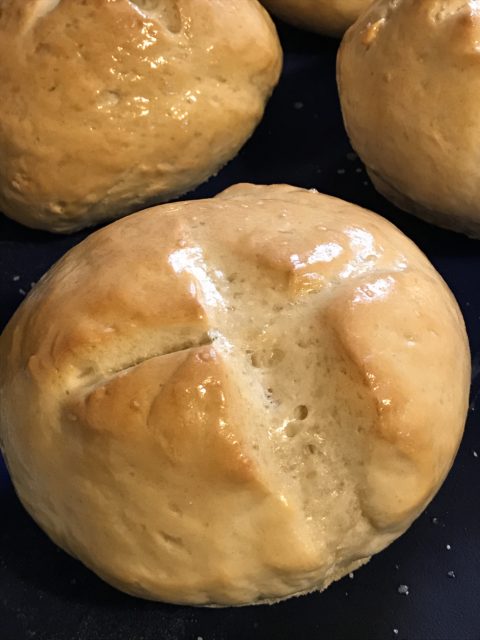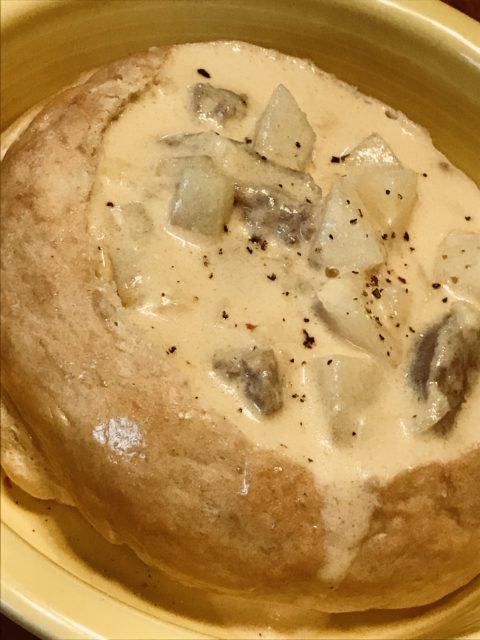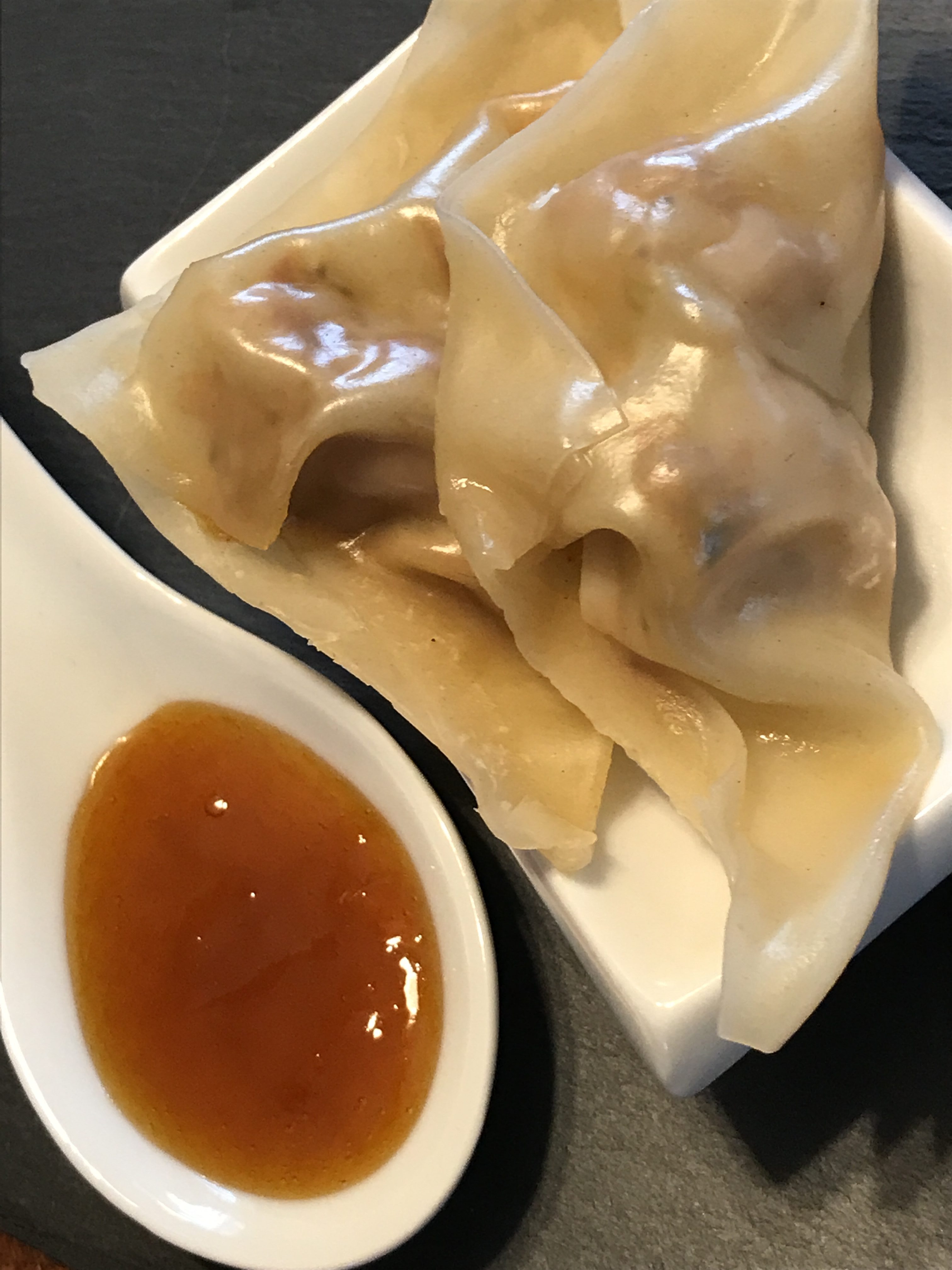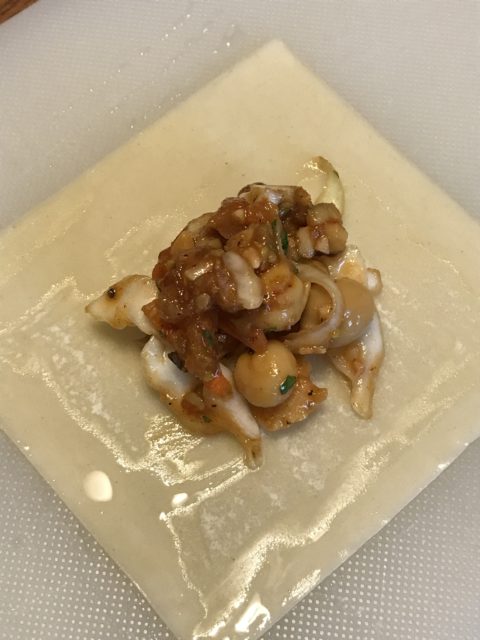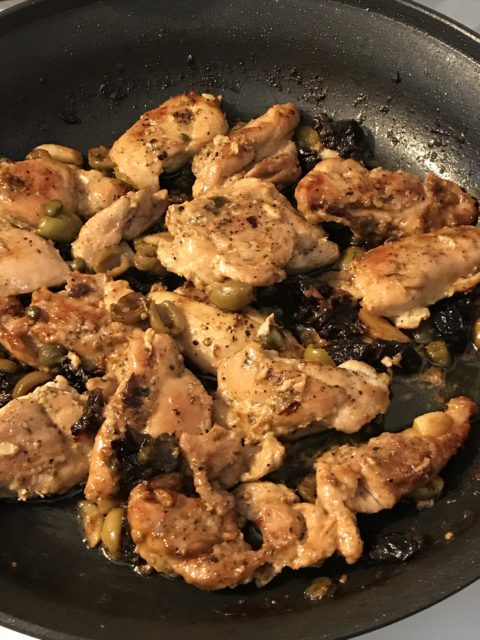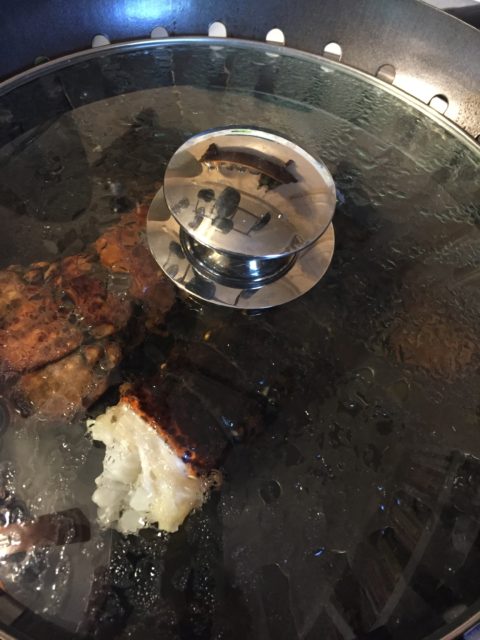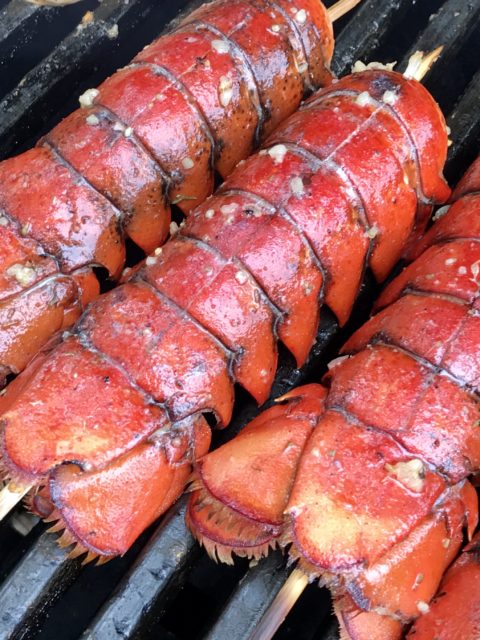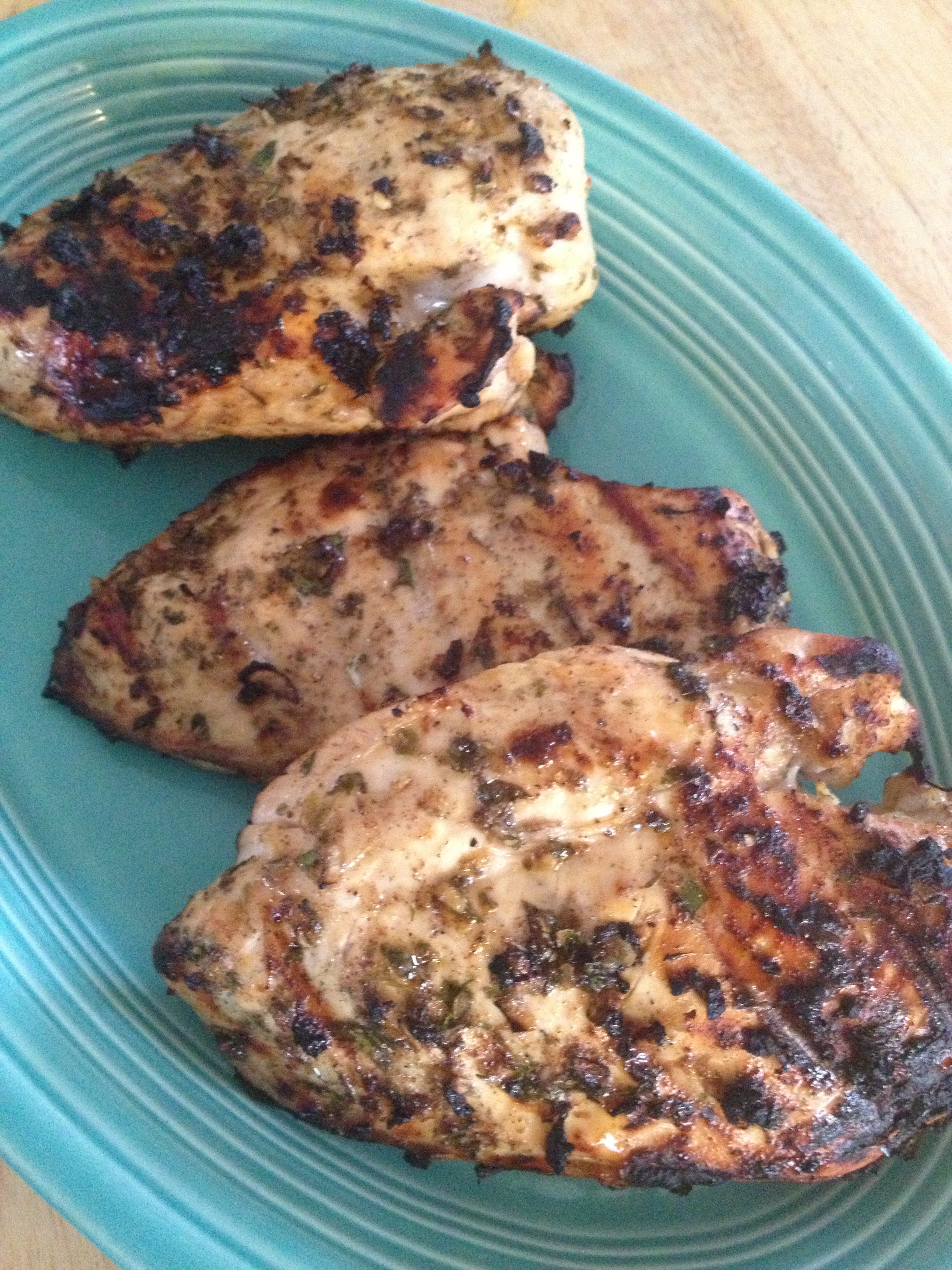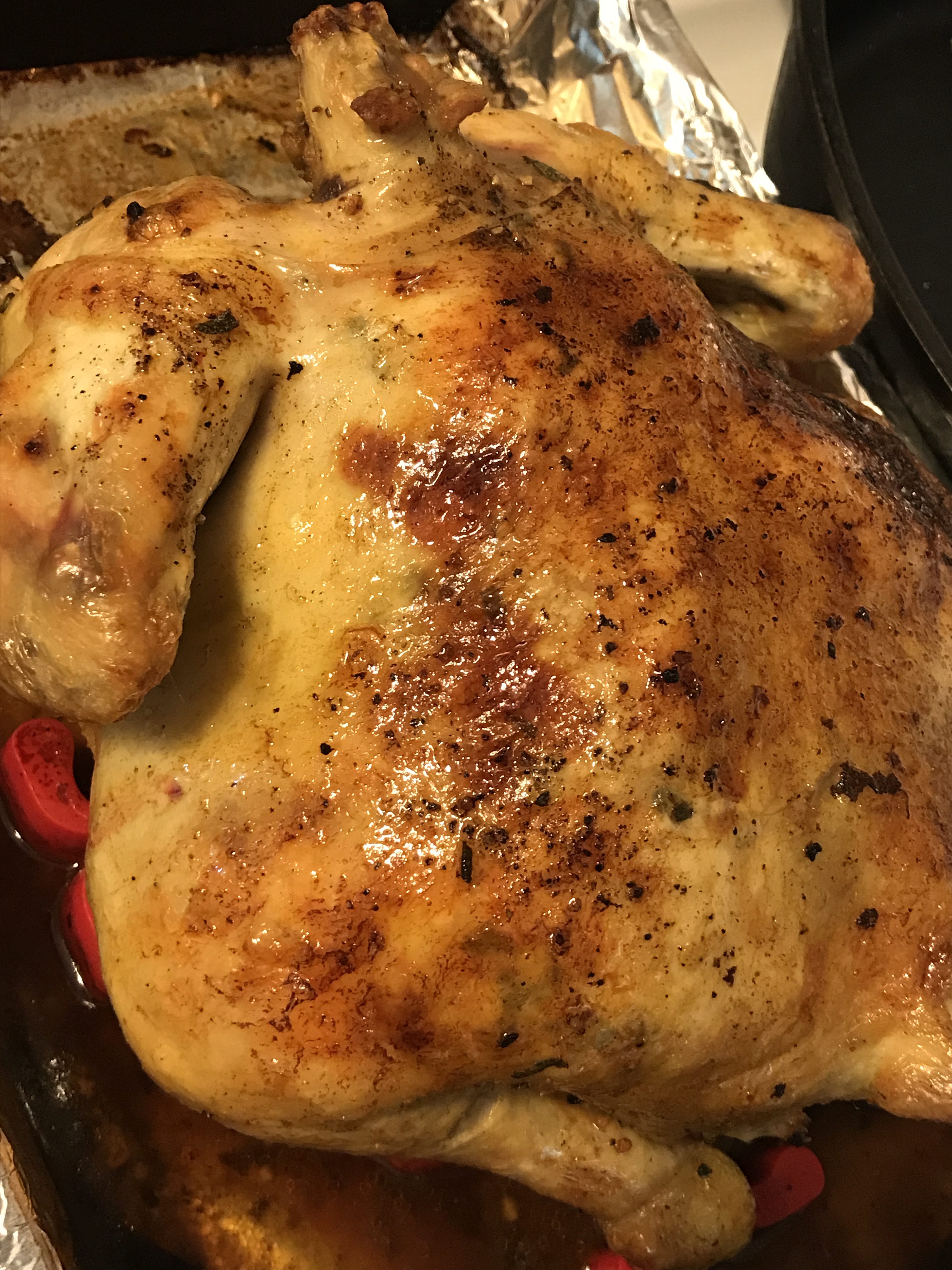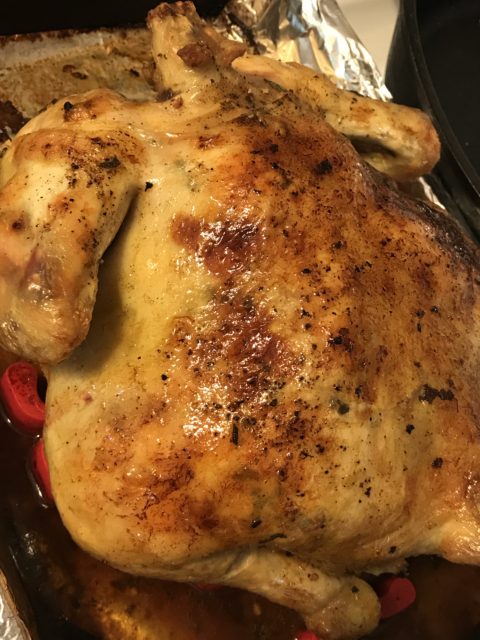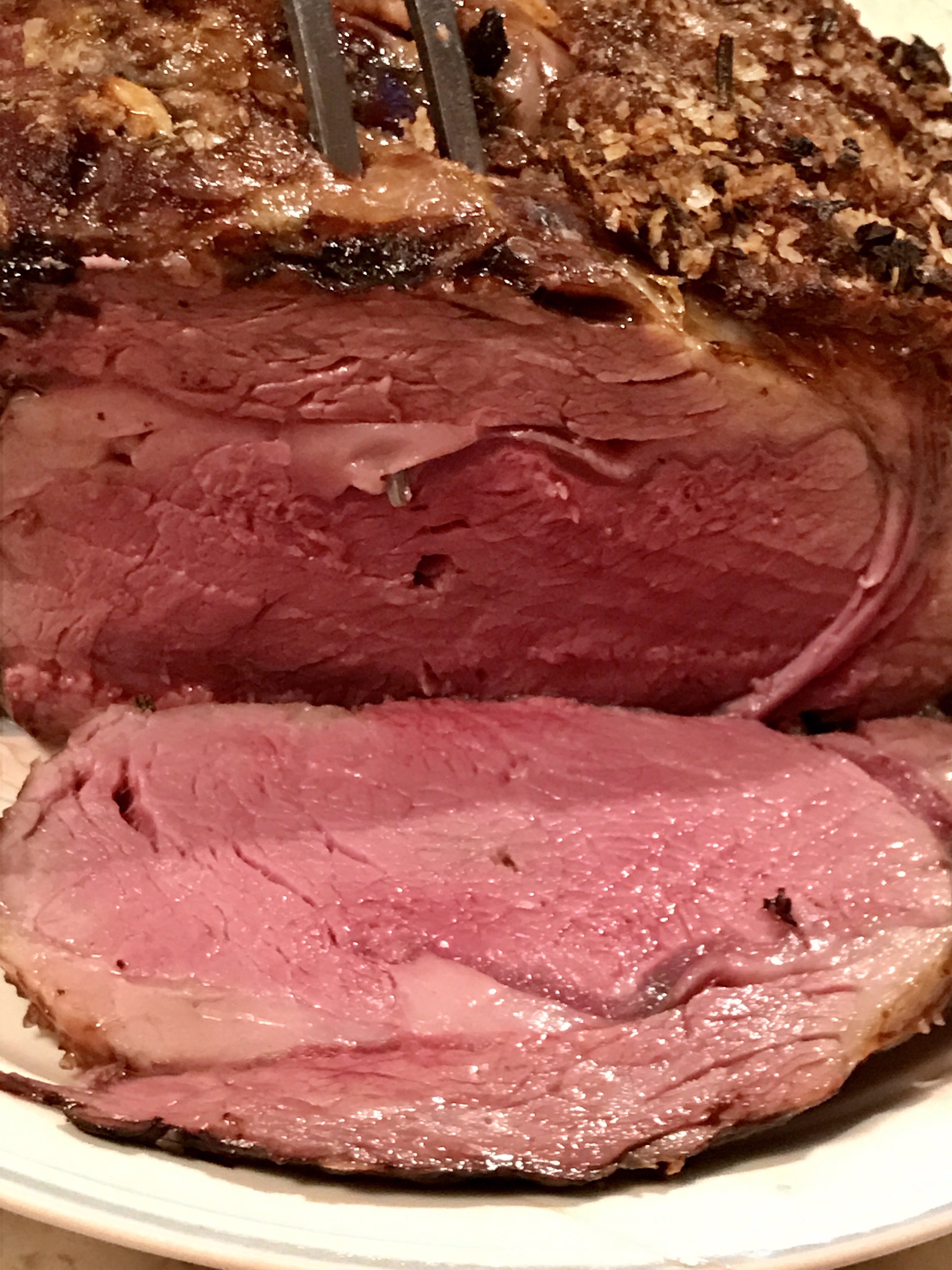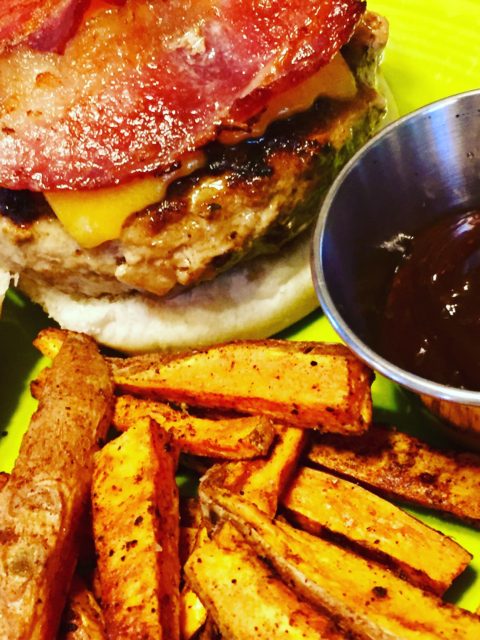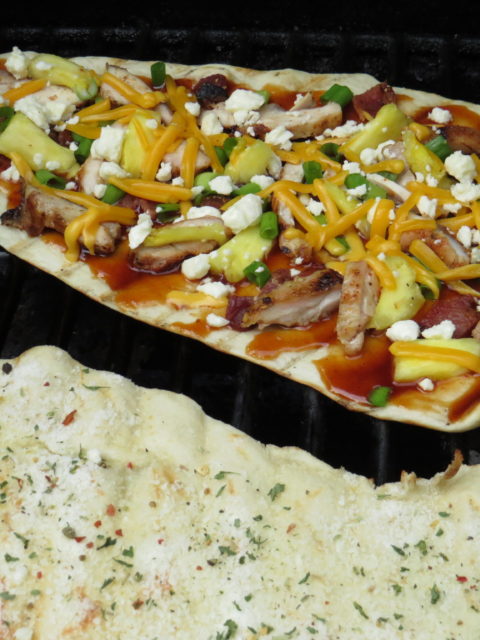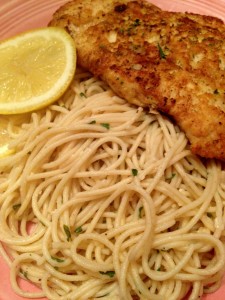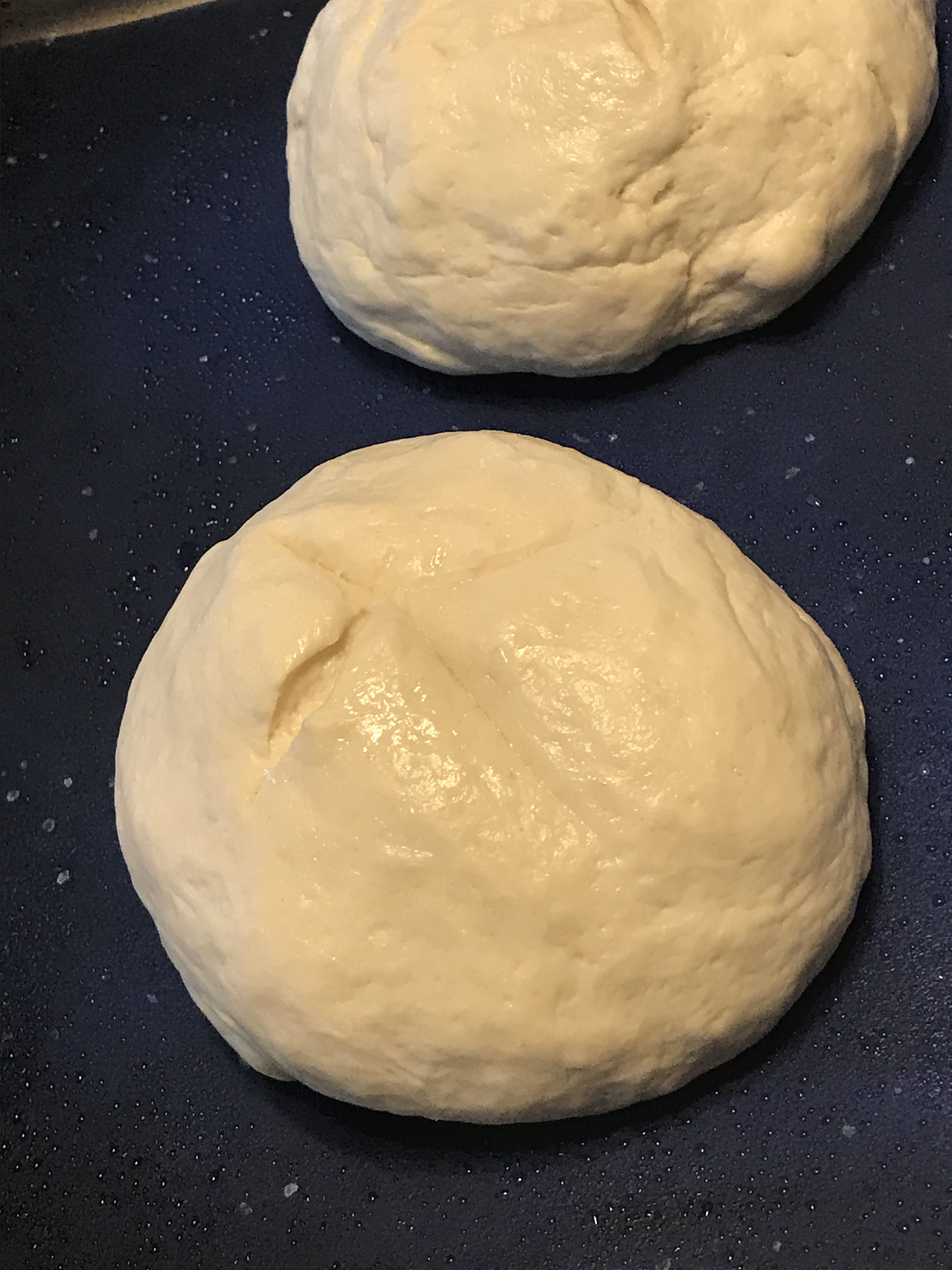
I often tell people I am a cook, not a baker. I think the biggest reason is that baking requires more precise use of ingredients; measuring, proofing, rising, etc. and I am a “toss a little of this and a little of that in” kind of girl. I am not very patient either. Waiting for something to chill or rise makes me stir crazy. It’s not that I don’t like all things baked, I do. I just would be happy if someone else did the preparation. This is my predicament. I love the smell of fresh baked breads. I love eating cookies when they are still g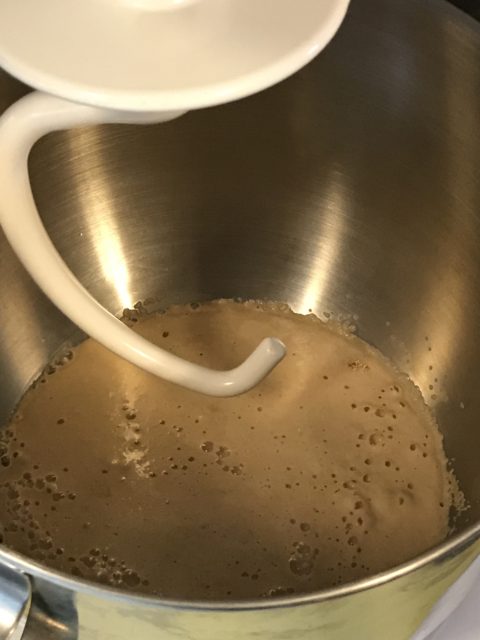 ooey, and bread when the butter melts and drips down my hand. And, I love steamy pies with a scoop of icy cold ice cream melting beside. So, sometimes I bake.
ooey, and bread when the butter melts and drips down my hand. And, I love steamy pies with a scoop of icy cold ice cream melting beside. So, sometimes I bake.
In addition to patience and precision, baking takes skill. Now, I think I have the skills needed, and I certainly know where to go if I feel I’m lacking knowledge. Other than the ever-ready brilliance of Siri and Alexa (what would we do without our phones and Echo type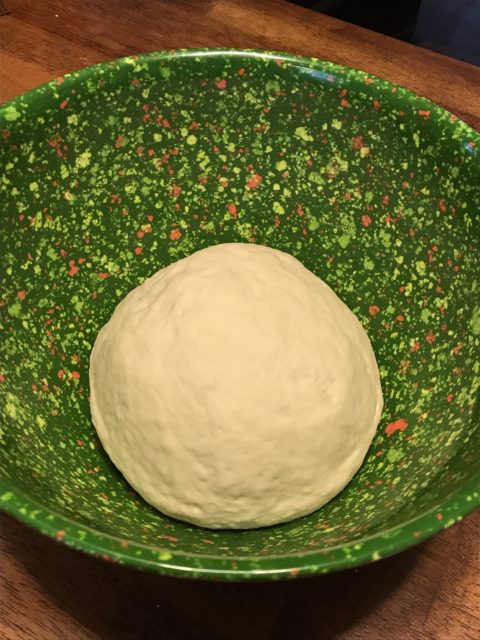 devices?), I can always call my mother. See, baking, in our family, seemed to skip generations. My great grandmother baked, my mother bakes, and my own daughter bakes. Me, not so much.
devices?), I can always call my mother. See, baking, in our family, seemed to skip generations. My great grandmother baked, my mother bakes, and my own daughter bakes. Me, not so much.
How happy I was to find an easy recipe for making one of my favorite breads: the bread bowl. As soup season is upon us here in the mid-west, for many soup recipes, the bread bowl is a considerably better vessel for serv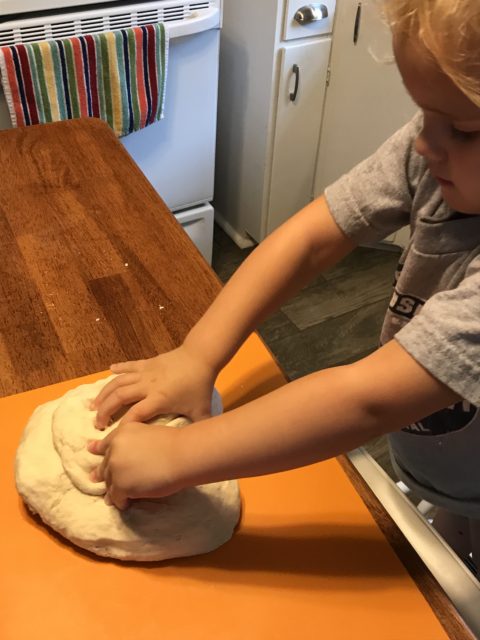 ing than any dish in the cupboard. Where I live, typical bakeries are those in the grocery and big box store. Occasionally, a vendor at the Farmers Market has baked goods, but that is hit and miss. It was time I learned to make them myself. This recipe was so easy, my 3 year old granddaughter, Adilyn, helped the first time.
ing than any dish in the cupboard. Where I live, typical bakeries are those in the grocery and big box store. Occasionally, a vendor at the Farmers Market has baked goods, but that is hit and miss. It was time I learned to make them myself. This recipe was so easy, my 3 year old granddaughter, Adilyn, helped the first time.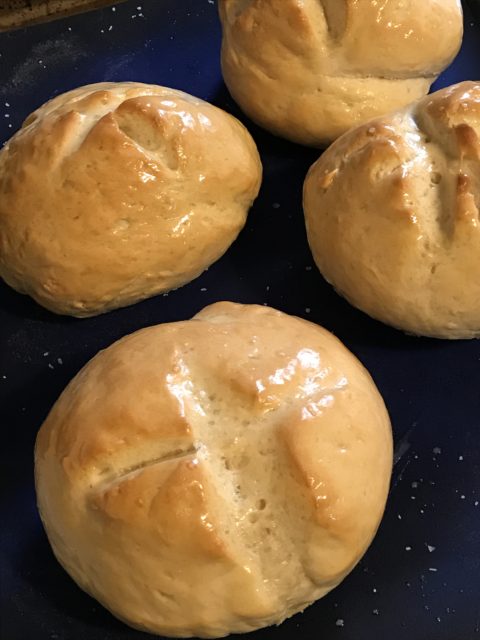
The bowls turned out great. Even though they weren’t exactly uniform in shape, the not too dense yet chewy texture and yeasty flavor were perfect. After they cooled, I stored them in a plastic bag in the refrigerator for several days. When I was ready to use them, I baked them at 350 degrees directly on the rack for about ten minutes until warmed through and the crusts were crunchy again.
The recipe isn’t mine. Credit belongs to The Baker Upstairs. A few tips though: I let the yeast proof a full ten minutes before adding the dry ingredients. I used a mixture of bread flour and all-purpose flour. Not for any particular reason other than when I first made the recipe, I didn’t have 3 1/2 cups of bread flour. But, it worked, so I continued with the half bread flour, half all-purpose flour. I kneaded the bread for nearly ten minutes the first time because I had a little person helping. It only took about 5-6 minutes to get the dough smooth the next time. I use a silicone baking mat on my baking sheets. Foods brown perfectly and don’t stick to the pan.
- 1½ cups warm water
- 2 tablespoons instant yeast
- 1 tablespoon sugar
- 3½ cups bread flour (or all-purpose flour, I used a mixture)
- 2 teaspoons salt
- Spray bottle with warm water
- In a large bowl or the bowl of a stand mixer, dissolve the yeast and sugar in the warm water. Let sit 10 minutes, or until bubbly and foamy.
- Add 3 cups of flour and the salt, and mix well.
- Add remaining flour, ¼ cup at a time, until the dough pulls away from the sides of the bowl and is only slightly sticky to the touch.
- Knead until smooth, 5-10 minutes.
- Place the dough in a lightly greased bowl, cover with a warm, damp towel, and let rise 30 minutes.
- After 30 minutes, preheat the oven to 500.
- Punch the dough down and divide into 4 equal sized pieces.
- Shape each piece into a ball and place on a lightly greased baking sheet.
- Score the top of each piece and sprinkle with salt.
- Spray with warm water and let rise 15 minutes.
- Bake in preheated oven for 2 minutes, then spray again with water and reduce the heat to 425. Bake 16-18 more minutes, or until golden brown.
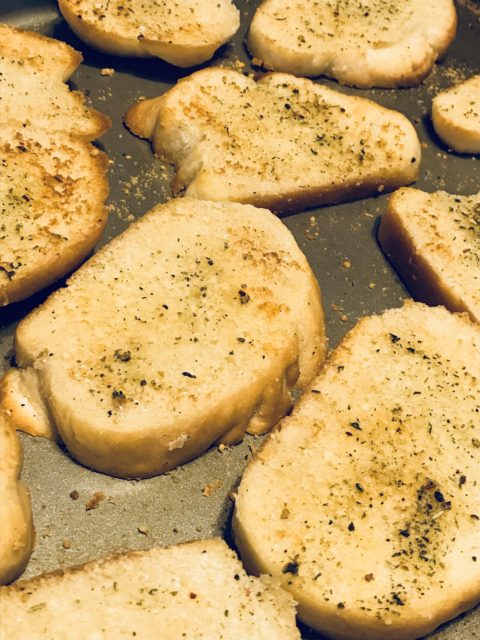
Other than being great bread bowls, this simple recipe just makes good bread. I didn’t need all of the bowls I made the other day so, one loaf was just eaten warm with butter. The other loaf was sliced and became garlic bread for a pasta meal. After buttering the slices and topping with grated parmesan, I sprinkled on Changing Seasonings Bread Dippin’ blend then baked. Tasty!
Chopped: ECA Edition, big fun!
The organization that I work for had a fun team building activity a couple of weeks ago that was right up my alley. Right up my alley, that made me snicker. Where did that phrase come from anyway? You know I am going to find out. And, apparently, the origin of the phrase goes back as early as the 1600’s, with the word “alley” referring to something being part of one’s province. The exact phrase is also documented in a 1931 court case. In the 1930’s the slang term “up one’s street” was commonly used in the same reference. Okay, I digress, but now we know.
Our team building committee came up with their own version of the popular Food Network show, Chopped. The rules were slightly different. Employees received an envelope of six unique “mystery ingredients.” There were several different lists. The challenge was to come up with a dish using at least three of the ingredients for a staff carry-in. Dishes were judged and awarded very interesting prizes in four categories: Most Creative Use of the Ingredients, Presentation, Taste (featuring at least 3 ingredients), and Most Ingredients Used with Best Taste. We weren’t timed and didn’t have to cook onsite, thankfully. However, it was just a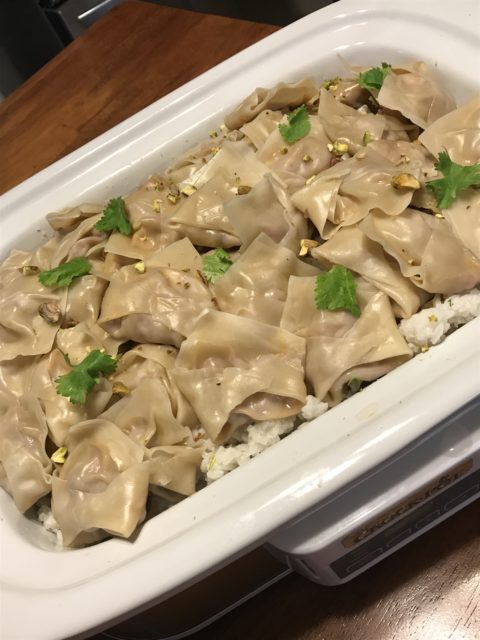 s challenging coming up with something that could be easily transported and re-heated. I am amazed we didn’t blow a fuse with all of the crockpots that were plugged in at the office that day!
s challenging coming up with something that could be easily transported and re-heated. I am amazed we didn’t blow a fuse with all of the crockpots that were plugged in at the office that day!
I was challenged to produce something fairly creative and tasty, first, because many of my co-workers know I own a food business so I figured they would have high expectations, and second, because I am just highly competitive. 🙂 I had a strategy. I did what I thought others would do, and searched the world wide web for recipes that used many of the ingredients on the list. The list I was given screamed “dessert” to me, and sure enough those were the type of recipes that popped up. My list included Apricot Preserves, Star Fruit, Coconut Milk, Wonton Wrappers, Pistachios, and Nutella. See, sounds like dessert.
So, I went another direction. Several of my ingredients are used in Moroccan cooking, which I love, and pair well with my Ras el Hanout blend. Ras el Hanout is a blend of “top shelf” spices including Coriander, Ginger, Cumin, Black Peppercorn, Turmeric, Cinnamon, Orris Root, Cardamom, Rose Petal, Fennel Seed, and Star Anise. The spices for this blend are first toasted to release the oils, then put through the grinder. They smell unique but amazing. I came up with the dumpling recipe by writing a variation of an Asian wonton or dumpling. Several of my co-workers are vegetarian so I decided to make the dumplings without meat. I could have used tofu, but I had chickpeas in the pantry, and use them in other Moroccan dishes, so chickpeas became the protein in the dumplings. Since Star Fruit isn’t readily available in my rural grocery, I decided to use it similar to dried apricots, and ordered the dried version from Amazon.
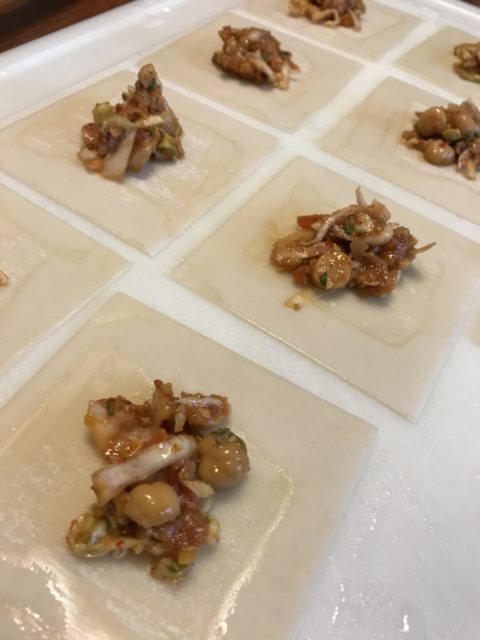 Now, let me just mention. Making dumplings takes skill. Skill that I apparently don’t have. It takes practice, lots of it! Folding them is time consuming. After you get the hang of it, the process goes a bit faster. But, plan on throwing a couple in the trash, and being okay if they aren’t even close to uniform. For the sake of space in the steamer and in the crockpot, I gave my dumplings an extra fold. I also folded and then steamed a
Now, let me just mention. Making dumplings takes skill. Skill that I apparently don’t have. It takes practice, lots of it! Folding them is time consuming. After you get the hang of it, the process goes a bit faster. But, plan on throwing a couple in the trash, and being okay if they aren’t even close to uniform. For the sake of space in the steamer and in the crockpot, I gave my dumplings an extra fold. I also folded and then steamed a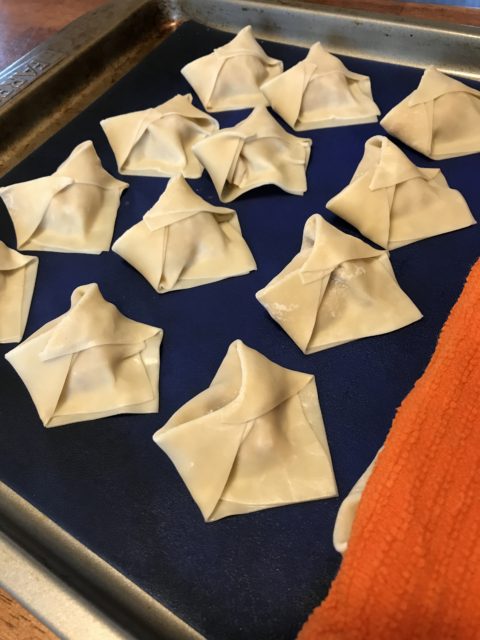 few dumplings to sample before attempting origami with the fragile little squares.
few dumplings to sample before attempting origami with the fragile little squares.
I know you all are w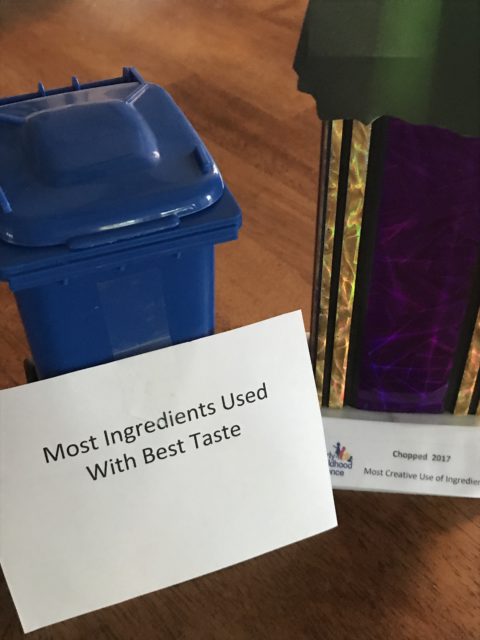 ondering. Yes, this tasty dish was the winner of not just one, but two of the categories. I was awarded a trophy for Most Creative Use of Ingredients, and a tiny garbage can full of candy for Most Ingredients with Best Taste. Kudos to the team building committee for their creative prizes! (Really guys, cash would have been just fine, haha!)
ondering. Yes, this tasty dish was the winner of not just one, but two of the categories. I was awarded a trophy for Most Creative Use of Ingredients, and a tiny garbage can full of candy for Most Ingredients with Best Taste. Kudos to the team building committee for their creative prizes! (Really guys, cash would have been just fine, haha!)
The dumplings would make a great appetizer. The rice can be served as a side dish to an entree such as Tangine Chicken Thighs. Or, you can serve the dumplings with the rice, as I did.
I would certainly suggest eating right away though both the rice and the dumplings did heat well in the crockpot. Another suggestion, prepare dumplings with children. Then you can put them to work on the tedious stuffing and folding. Win, win! They get a cooking lesson, and you don’t have to fold. Enjoy!
- For Dumplings:
- 1 15oz can Chick Peas (can substitute ½lb firm Tofu or ground pork or turkey)
- 1 ½ C Slaw Mix (or chopped cabbage and carrots)
- 2T Scallions
- 2t grated fresh ginger
- 1T Harissa
- 2T chopped Pistachios
- 2T chopped dried Star Fruit
- 1T fresh Cilantro
- 1t (1clove) minced fresh Garlic
- 1T Soy Sauce
- 2t Sesame Oil
- 1 Egg
- 1t Kosher Salt
- ¼t ground Pepper
- ½t Ras el Hanout seasonings
- 35-40 Wonton Wrappers
- For Dipping Sauce:
- 1 12oz jar Apricot Preserves
- 1T Soy Sauce
- ¼ C Rice Vinegar
- For Rice:
- 1 C Jasmine Rice uncooked
- 2 ½ C Coconut Milk (can add water to make full amount)
- ½ t grated fresh Nutmeg
- ½ t grated fresh Ginger
- 1T chopped fresh Cilantro
- Juice of ½ fresh Lime
- Mix dumpling ingredients except wrappers.
- Use 1t filling for each wonton.
- Wet and seal edges.
- Steam for 10-12 minutes.
- Whisk together the sauce ingredients. Reserve for dumpling dipping.
- Cook rice to package instructions.
- Add nutmeg and ginger while cooking.
- Add lime juice and cilantro before serving.
- Garnish with chopped pistachios.
I made a variation of Chicken Marbella for dinner the other night. Like many new recipes I try, I wanted to do a little research about the origin of the dish. The first recipe I found described the dish as an Italian-American preparation. The next several recipes, said the dish was French, hmmm. Puzzled, I looked further, and discovered that Marbella is a city on the Mediterranean coast of Spain (a beautiful place that I have actually traveled, though I was a bit to the east). The ingredients including olives, capers, garlic and prunes, seem to fit with the dish being more Spanish. Further research led me to Slow Burning Passion where I uncovered the story of Sheila Lukins, the Jewish New Yorker who is credited for developing the recipe. I was happy to read that Ms. Lukins did travel the Mediterranean, and was inspired by Spanish and North African cuisine. So, though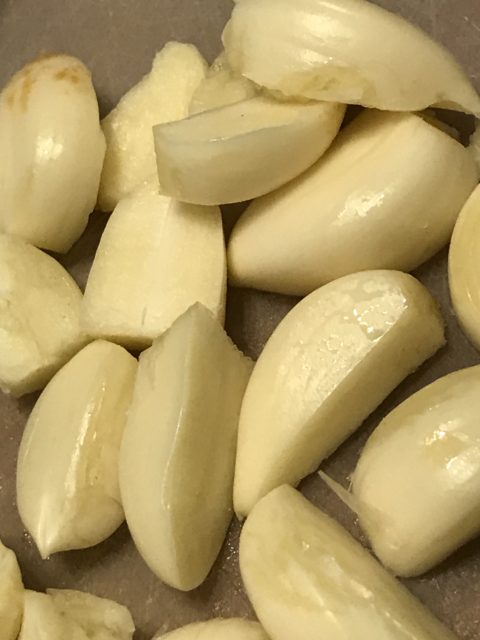 it was born in New York, I still think of this as a Mediterranean dish.
it was born in New York, I still think of this as a Mediterranean dish.
I love to combine sweet and savory, and use fruit in many dishes. And, though people tend to think of prunes in a more, umm, functional manner, I love them. Really, there is nothing in this recipe that I don’t adore: garlic, olives, chicken thighs…yum! I, perhaps, use a tad bit more garlic than the traditional Chicken Marbella recipes call for because, well, it’s garlic!
I have seen this dish prepared two ways. One roasts the chicken thigh pieces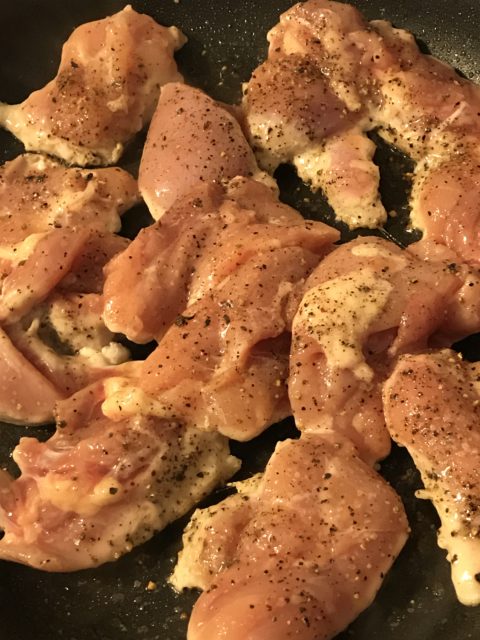 in the oven while making the sauce on the stove top, and then adds the thighs to the sauce. The other, the one that I used, browns the thighs in a pan on the stove, sets them aside, makes the sauce using the drippings in the pan, and then returns the thighs to the pan, and finishes the dish in the oven.
in the oven while making the sauce on the stove top, and then adds the thighs to the sauce. The other, the one that I used, browns the thighs in a pan on the stove, sets them aside, makes the sauce using the drippings in the pan, and then returns the thighs to the pan, and finishes the dish in the oven. 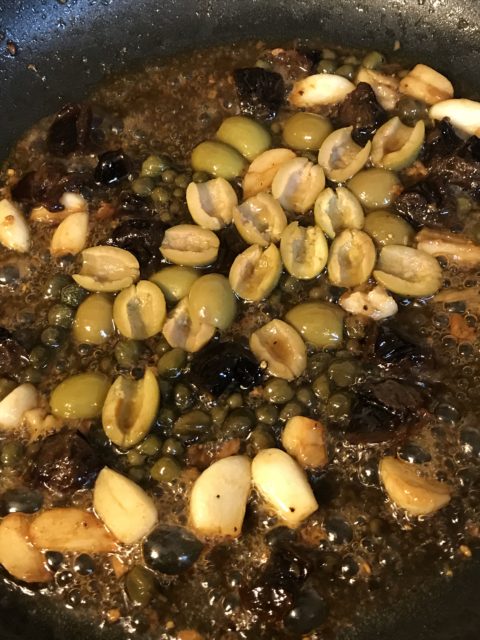
After trying this dish, I am certain there will be more of it in my future. It was so tasty that I ate the leftovers for breakfast the following day. I reheated it (though I may have eaten a couple cloves of garlic and an olive or two, cold, right out of the container).
- 1½ lbs Boneless Skinless Chicken Thighs
- 1 small head of Garlic (about 6 cloves, cut each clove in half)
- 4 pitted Prunes (cut in pieces and rehydrated in ⅓ C warm water)
- 1 T Capers
- 8-10 Green Olives (pitted, without pimentos and sliced in half)
- 1 T Brown Sugar
- 2 T Butter
- 1½ T Sherry Vinegar
- 1-2 sprigs fresh Oregano
- Olive oil
- Preheat the oven to 465 degrees.
- Heat olive oil over medium high heat in a skillet that can go in the oven.
- Brown both sides of the chicken thighs, then remove and set aside.
- In the same skillet with the chicken renderings, add a little more olive oil.
- Toss in the garlic a stir while it cooks for 1-2 minutes.
- Add the prunes with their water, capers, olives, brown sugar, and vinegar.
- Stir and let reduce about 2 more minutes.
- Add butter to finish sauce.
- Add the chicken back in.
- Top with the sprigs of oregano.
- Put in the oven and cook 12-14 minutes.
- Remove the oregano stems before serving.
Lobster Facts: Lobsters can grow up to four feet long and weigh as much as 40 pounds.
It is believed that lobsters can live as long as 100 years.
And, lobsters do not mate for life (this one bummed me!).
National Lobster Day was in June (15th). I promised to share a post on how easy it is to grill lobster. I decided to share a simple steaming method too because National Macaroni and Cheese Day (July 14) is today, and Lobster Mac & Cheese is simply amazing! Use my Grown-up Mac & Cheese recipe substituting lobster tail chunks for the bacon and seasoning with Changing Seasonings Calypso Blend or for an extra bite, Spicy Shrimp Blend.
Lobster is soooo much better (& cheaper!) when you do it yourself. Tails are a great beginner lobster dish. Unless you are doing surf & turf and lobster isn’t the main attraction, plan on two tails per person. I recently purchased beautiful tails, about 4-6 oz each, for $3.99 a tail on sale. I went out to dinner soon after and the restaurant wanted $36 for a two 6 oz tail dinner. Crazy! Steamed or grilled they are quick and easy to prepare.
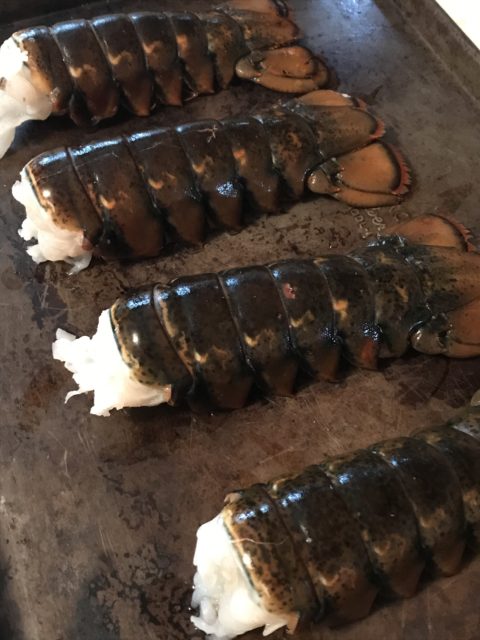 So let’s talk basic lobster first. Buying and cooking fresh whole lobster is a post of it’s own. I prefer tails for several reasons including price, ease of storage, and ease of preparation. They provide the perfect amount of the tender buttery meat needed with less work. The tails are arguably the best part of the lobster. Lobster are typically categorized by where they grow, cold water (like Maine) or warm water (like Florida or the Caribbean). It is rumored that the lobsters from cold water are the best texture and flavor. You can ask the grocer where the tails are from. If they aren’t marked, they are probably warm water. Cold water lobster are sometimes a bit more expensive, but worth the extra cost. Honestly, here in the Midwest, I get excited to find good lobster on sale regardless of where it came from. Use your eyes and nose when choosing tails. Though shells vary, you can sometimes tell by the markings where the lobster originated. Black spots on the shell or yellow banding is a sign of warm water lobster. Regardless of warm or cold water, be sure that the meat is white. Yellowing or black spots on the meat are a sign of bad lobster. The lobster should smell “clean,” not overly fishy smelling or have an ammonia smell.
So let’s talk basic lobster first. Buying and cooking fresh whole lobster is a post of it’s own. I prefer tails for several reasons including price, ease of storage, and ease of preparation. They provide the perfect amount of the tender buttery meat needed with less work. The tails are arguably the best part of the lobster. Lobster are typically categorized by where they grow, cold water (like Maine) or warm water (like Florida or the Caribbean). It is rumored that the lobsters from cold water are the best texture and flavor. You can ask the grocer where the tails are from. If they aren’t marked, they are probably warm water. Cold water lobster are sometimes a bit more expensive, but worth the extra cost. Honestly, here in the Midwest, I get excited to find good lobster on sale regardless of where it came from. Use your eyes and nose when choosing tails. Though shells vary, you can sometimes tell by the markings where the lobster originated. Black spots on the shell or yellow banding is a sign of warm water lobster. Regardless of warm or cold water, be sure that the meat is white. Yellowing or black spots on the meat are a sign of bad lobster. The lobster should smell “clean,” not overly fishy smelling or have an ammonia smell.
So first, steaming. Steaming lobster tails is a simple and healthy way to prepare them. Steaming also preserves the flavor instead of boiling it away. You don’t need any fancy equipment to steam, just a large pot (like your spaghetti pot), a splatter guard, steaming basket or even a grill pan/basket (pictured here), and a lid. Fill the pot with water. You can add a quartered lemon, salt, and a bay leaf for extra flavor. Bring the water to a boil. Set your choice of steamers on the pot and place the lobster tails on top. Three to four tails will fit. Put the lid on top of the tails. Steam for eight (8) minutes. The meat will be firm, turn white and be opaque. Opaque means non-transparent or not able to see through.
Grilling lobster tails is just about as quick. There are a couple additional steps. The extra flavor will come from a mixture of melted butter, minced garlic, cracked peppercorn, and lemon juice used for basting. I added Changing Seasonings Calypso Blend. Put a skewer through the tail to keep it from curling as it cooks. If they are wooden skewers, be sure to soak them in water for 10-20 minutes before using so that they won’t burn on the grill. Nex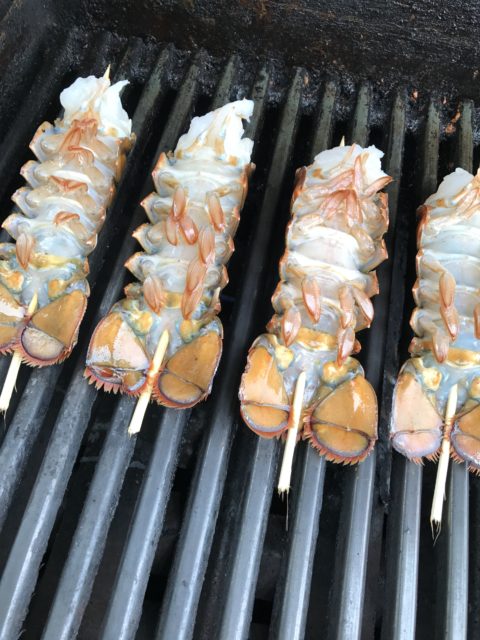 t, cut the shell from the meaty end to the last segment of the tail and pull apart slightly. This will allow the butter to get to the meat while basting. Put the tails, shell side down, on the grill at medium heat. Grill for 7-8 minutes with the lid down. Flip the tails over and baste generously being sure to work the butter mixture into the opened shell. Continue cooking with the lid down for another 5 minutes. Again, the meat will be firm, white and opaque. Baste once more before serving. Because the shells are already cut, it is easy to remove the meat by just pulling the shell apart and pushing the meat up through the shell.
t, cut the shell from the meaty end to the last segment of the tail and pull apart slightly. This will allow the butter to get to the meat while basting. Put the tails, shell side down, on the grill at medium heat. Grill for 7-8 minutes with the lid down. Flip the tails over and baste generously being sure to work the butter mixture into the opened shell. Continue cooking with the lid down for another 5 minutes. Again, the meat will be firm, white and opaque. Baste once more before serving. Because the shells are already cut, it is easy to remove the meat by just pulling the shell apart and pushing the meat up through the shell.
Serve lobster with extra melted butter for dipping and lemon wedges. Once you discover how simple it is to cook lobster yourself, and how much money you will save, you will eat like royalty more often. Oh, and speaking of that, here is one more lobster fact: lobster was once considered a pauper’s meal because it was so readily available. Now we pay $36 for a couple of tails at a restaurant, or not.
Have I mentioned I LOVE grilling season! Honestly, I could grill every day if I didn’t live where more than half the year it is either freezing or raining. Yes, I could still drag the grill out. It’s just not as fun to stand outside shivering and wet while cooking.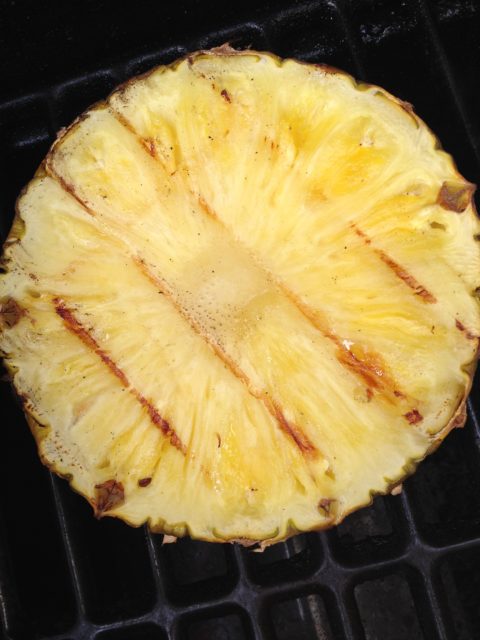
One of my favorite seasoning blends for grilling is jerk seasoning. It is perfect for chicken and pork. You can order Changing Seasonings Island Spice from the online market page, or make your own using the recipe below. Jerk is spicy with the unique flavor of Allspice. I typically grill fruit such as pineapple or peaches with the meat, and then serve over brown rice or quinoa.
Allspice comes from tropical Central America and West Indies. Like Cloves, Allspice has a very unique, pungent flavor. It is used in cooking all around the world from the Caribbean to Europe to the Middle East. It compliments meats, vegetables (especially squash and root vegetables, and fruits). It is even used in baking cakes, pies and other deserts.
If you have read other posts, you know that I actually prefer chicken thighs. They are more juicy and flavorful. It just happens that I had breasts to use when I wrote this. Tenders or even drumsticks would work well too. Use your favorite.
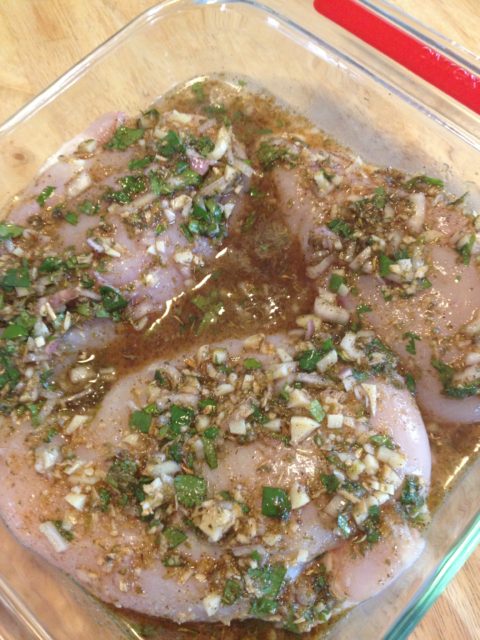 Combine the ingredients to make a marinade. Meat doesn’t have to marinate very long, 1 – 4 hours is plenty. In fact, many cuts of meat will actually lose texture and become grainy if left in the marinade too long. Do not use the excess marinade to baste the meat unless it will be cooked fully. Reserve some of the marinade before putting the raw meat in it for that purpose, just to be safe.
Combine the ingredients to make a marinade. Meat doesn’t have to marinate very long, 1 – 4 hours is plenty. In fact, many cuts of meat will actually lose texture and become grainy if left in the marinade too long. Do not use the excess marinade to baste the meat unless it will be cooked fully. Reserve some of the marinade before putting the raw meat in it for that purpose, just to be safe.
This marinade is great for pork and shrimp too. Season with additional jerk seasoning and garnish with grilled fruit before serving.
Caribbean Jerk Chicken
3-4 Boneless, Skinless Chicken Breasts, halved (or your favorite chicken pieces)
1 Medium Lemon, juiced + 2 T zest
1 Lime, juiced + 1 T zest
3 T Olive Oil
1/2 C Coconut Rum (optional – plain light Rum or Tequila could also be used)
2 T Shallot, minced (about 1/2 large shallot)
2 large Cloves Garlic, minced
2 T Jerk Spice mixture*
Mix the lemon juice (about 3 T), lime juice (about 2 T), zest and olive oil. Add the jerk spice, minced shallot and garlic. Whisk in the rum. Pour over the chicken and refrigerate for at least an hour.
*Jerk Spice Mix
1 T dried minced garlic
3 t cayenne pepper
2 t onion flakes
2 t dried thyme
2 t dried parsley
2 t dark brown sugar
2 t kosher salt
1 t paprika
1 t ground allspice
1 t coarse ground peppercorns
1/2 t dried crushed red pepper flakes
1/2 t fresh ground nutmeg
1/4 t ground cinnamon
Mix the ingredients and store in an air tight container away from heat and light for 6 months.
- 3-4 Boneless, Skinless Chicken Breasts, halved
- 1 Medium Lemon, juiced + 2 T zest
- 1 Lime, juiced + 1 T zest
- 3 T Olive Oil
- ½ C Coconut Rum (plain light Rum or Tequila could also be used)
- 2 T Shallot, minced (about ½ large shallot)
- 2 large Cloves Garlic, minced
- 2 T Jerk Spice mixture*
- Mix the lemon juice (about 3 T), lime juice (about 2 T), zest and olive oil.
- Add the jerk spice, minced shallot and garlic.
- Whisk in the rum.
- Pour over the chicken and refrigerate for at least an hour.
- Grill chicken until required doneness.
Whole chickens are inexpensive. I buy them when they are on sale for about $4 for a 3-5 pound chicken. Cooking chicken with the bone and skin will be tender and have the most flavor. The best part, cooking a whole chicken is simple, and they can look quite elegant when you serve them. I have written previously about preparing chicken “rotisserie” style on the grill in my Beer Butt Chicken post. But, the evening I wrote this, I was dodging thunderstorms so I decided to just roast the chicken in the oven.
This post isn’t so much about the flavors because you can use whatever sounds good. I’m doing my go-to favorite: Lemon Garlic Rosemary Roast Chicken. I am rubbing the chicken beneath and on top of the skin with a compound butter made by mixing softened butter with minced fresh garlic and chopped fresh rosemary. I squeezed the juice of a lemon over the chicken and stuffed the cavity with the lemon and sprigs of fresh rosemary. This post is more about the technique. Once you know how to roast a chicken, you can get creative. Some other ideas include lemon or orange, thyme, Cajun spices, paprika, and …
Okay, to roast a chicken you need to have some kind of a roasting pan. The higher the sides, the less splatter and the more brown the sides of the chicken will get. Many roasting pans come with a rack to elevate the meat, another reason you want the sides to be a bit higher. If you don’t have a rack, you can form one out of aluminum foil. I use a silicone roasting rack that can be used in any pan. By elevating the meat, it browns more evenly and doesn’t sit in the grease or juices that come off of the meat. A lid isn’t necessary. If the top of the roast is browning too quickly, lay a piece of foil over it. Foil can be your friend when roasting. I also line the roasting pan with it to make clean up easier.
It is good to have a meat thermometer so that you will know when the meat has reached the desired internal temperature. For chicken, 155-160 degrees. Remember that the meat will continue to cook in the ten minutes after you remove it from the oven and allow the juices to redistribute. A 3-5 pound chicken that is fully defrosted will take about 80-90 minutes at 425 degrees.
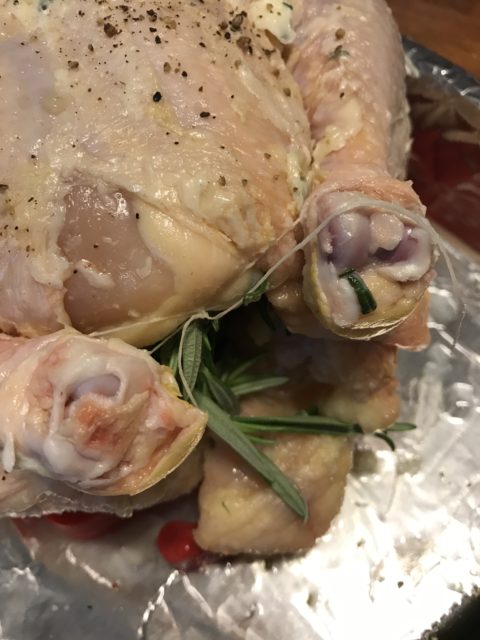 Preheat the oven to 425 degrees. Prepare the chicken by making sure the giblets are removed from the cavity, dry the skin so you can season it, and secure the wings and legs. You can tie them in technique called trussing by tucking the wings behind the back and securing with twine over the legs, around the back, and then down around the feet. Or, you can simply cut little pockets to tuck the wings in to and tie the feet together. If you do not have twine, you can use dental floss. Just don’t use mint flavored unless it compliments the seasonings you are using, haha!
Preheat the oven to 425 degrees. Prepare the chicken by making sure the giblets are removed from the cavity, dry the skin so you can season it, and secure the wings and legs. You can tie them in technique called trussing by tucking the wings behind the back and securing with twine over the legs, around the back, and then down around the feet. Or, you can simply cut little pockets to tuck the wings in to and tie the feet together. If you do not have twine, you can use dental floss. Just don’t use mint flavored unless it compliments the seasonings you are using, haha!
Now, here is a part of the process that can be a bit controversial. Breast up or breast down?? I say breast up for the first 20-30 minutes to crisp the skin and seal in the juices. Then, flip the chicken over for the remaining cooking time to keep the breast meat tender as the juices flow downward. Pour a half cup or so of liquid in the bottom of the pan. Water, juice, wine or a combination will work. Add more if needed as the liquid evaporates. The juices from the meat will mix with the liquid and can be used to baste the chicken periodically.
That’s it! Other than the initial flipping of the bird, and the periodic basting and watching for over-browning of the skin, the chicken becomes a beautiful, juicy, flavorful meal practically on its own. If you want to get really fancy, toss some cut up vegetables such a carrots, onions, and potatoes in the bottom of the pan for the last 30-40 minutes of the cooking and you have a pretty  side dish. Simple.
side dish. Simple.
Click here for your chance to WIN a FREE Silicone Roasting Rack. You must be 18+ to enter, live in the 50 United States or District of Columbia, and answer a poll question (hint: it’s about this post). The winner will be randomly selected after July 2, 2017. The prize will be shipped directly to the winner from Amazon, and the winner must have an Amazon.com account. No purchase necessary to be entered or win.
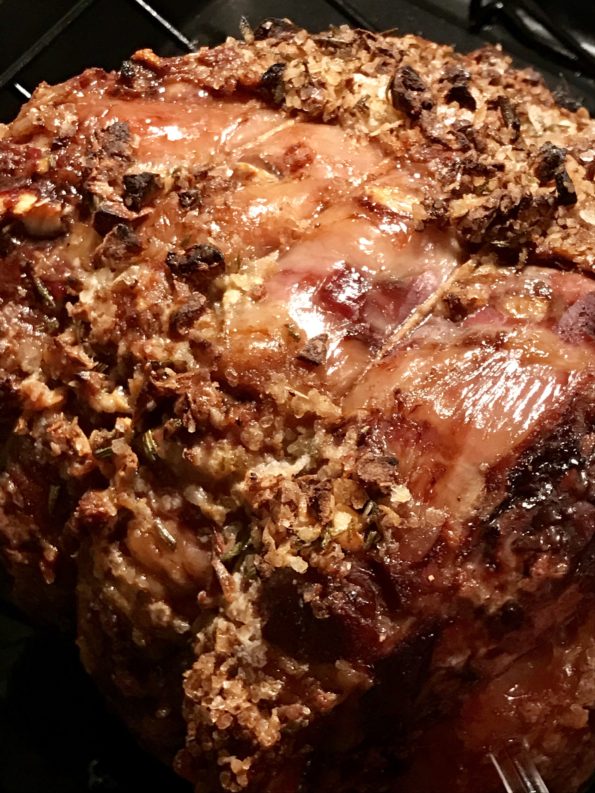
It’s National Prime Rib Day, which I think should be every day (or at least alternated with National Bacon Day)! I used to think prime rib was only for eating out. I’ve had some very, very good prime rib at restaurants. It always seems so special because many restaurants only serve it on certain days. I thought it must be very complicated to prepare. I’ve even had those utterly disappointing moments when I was told that the restaurant was out of prime rib for the night. So sad. Here’s the thing, prime rib is simple to prepare, and it is considerably less expensive than ordering it at a restaurant. Oh, and you can eat as many slices as you want!
The first thing you will want to consider is how large of a roast you need. How many people will you be serving? You should have about one pound per person. You can also look at it this way, each rib serves 2-3 people. A roast is at least two ribs, typically 3-7 ribs. One rib isn’t even a roast, just a really big steak. Don’t forget to go a little larger if you want leftovers. The next, very important, step is to have the butcher cut the roast away from the ribs (it’s a task better left to the pro and will make it easier to carve when cooked). Have him leave it sitting on the ribs though to cook because the bones give flavor to the meat. The only other thought when purchasing the roast is the quality of the meat. Although Prime grade is typically restaurant level, you can chose to pay a little more but definitely go at least Choice. A rib roast should be flavorful of its own accord. It doesn’t require marinating, though I do like to compliment the meat with flavors I love: fresh garlic and rosemary.
The next steps can get a bit controversial. To salt or not to salt?? I salt. Some people will say that the salt draws the moisture out of the meat. That is not my experience, but I also only cook my roast to rare-medium rare so it is naturally more juicy. Then, to sear or not to sear?? Searing is done by cooking the meat at a high temperature briefly. Searing puts a crust on the roast. I like the crust, hence the recipe name. I think the searing helps hold in some of the moisture too. I flavor the meat two ways. The first is by inserting cloves of garlic throughout slits in the roast. The second is a crust of chopped fresh rosemary, minced garlic, large granule sea salt, and crushed rainbow peppercorn rubbed all over the outside of the roast.
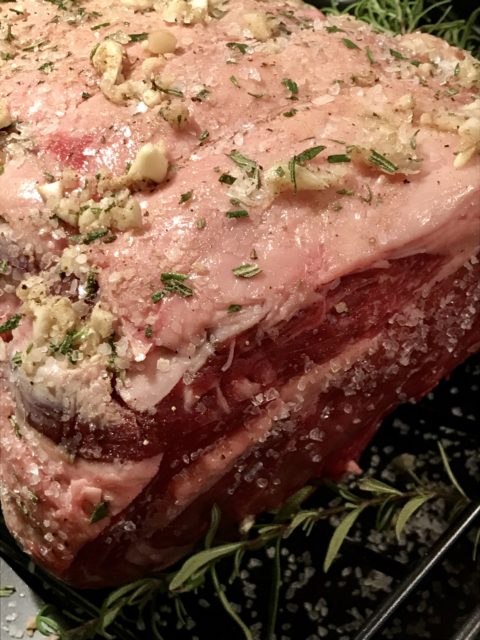
Place the roast in the pan with the fat side up. Cook for about 15 minutes at 450 degrees. Turn the temperature down to 325 degrees and cook for the remaining time, about 12-16 minutes per pound or until the internal temperatures are as follows:
Rare: 115 °F (46 °C).
Medium rare: 130 °F (55 °C).
Medium: 145 °F (63 °C). DO NOT go here or any more done! Seriously, if you don’t want pink, just eat chicken.
Once the roast reaches the desired temperature, remove it from the oven and let it sit for about ten minutes before slicing to allow the juices the redistribute. Serve with the juice of the meat, au jus, and a little horseradish. You can make or purchase horseradish sauce, but I prefer fresh horseradish. A little goes a long way.
Leftovers make great French dip sandwiches. It can also be sliced in strips for a salad.
- Rib Roast
- Fresh Garlic Cloves (8-10 peeled whole & 3 cloves minced)
- Fresh Rosemary (about ¼ C chopped)
- 2-3 T Large Granule Sea Salt
- 1-2 T Crushed Rainbow Peppercorn
- Preheat oven to 450 degrees
- Place rib side down in a roasting pan
- Cut 8-10 slits in the roast and place a clove of garlic in each
- Mix the minced garlic, rosemary, salt and pepper
- Rub the seasoning mixture all over the roast
- Cook for 15 minutes
- Reduce the oven temperature to 325 degrees
- Cook the remaining time (about 12-16 minutes per pound)
- When the internal temperature reaches about 130 degrees (for Medium Rare), remove from oven
- Let sit for 10 minutes before carving
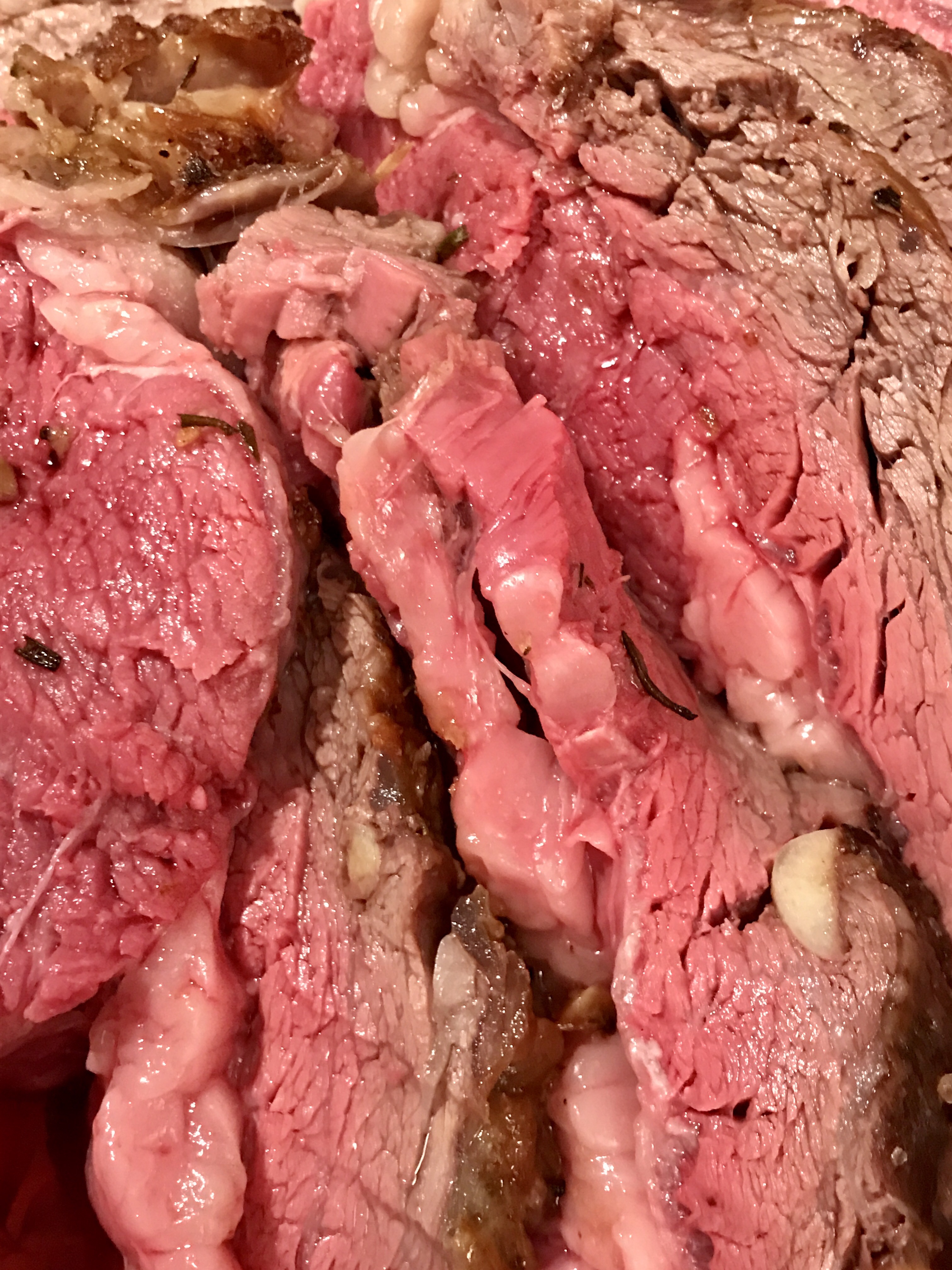
I love burgers, and much like my love for pizza, I love all types: beef, chicken, veggie, and turkey. I would be lying if I said I didn’t have a favorite though. A thick, juicy, medium rare beef burger is top on my list, but this turkey burger is now rivaling my Four Cheese Chicken Burgers for second place.
Face it, sometimes cooked ground chicken and turkey can be dry and a bit flavorless, even when you choose the less lean white and dark meat mixture. The key to making a great turkey burger is using ingredients that help keep the meat juicy and add great flavor. Unlike with beef, when you bite into a chicken or turkey burger, you aren’t expecting to taste good quality meat. So, you can have a little fun. There are Gre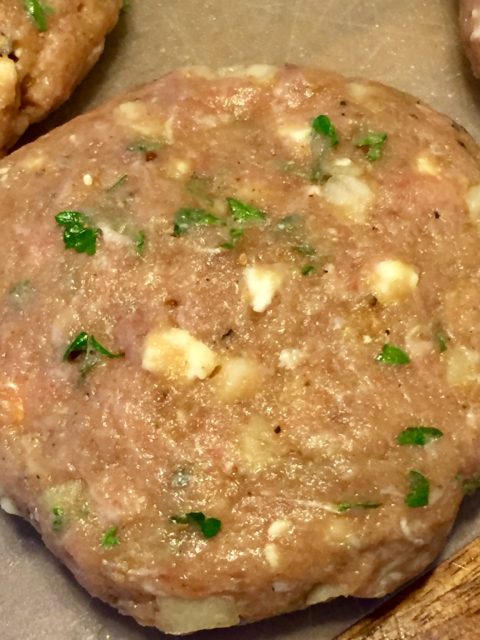 ek burger, Southwestern burger, and Italian burger recipes available just to name a few. This turkey burger combines one of my favorite fall flavors, apple, with the complimentary flavors of cheddar cheese, applewood bacon and BBQ sauce. The apple adds both flavor and juiciness, but isn’t over-powering. The fresh parsley also helps keep the meat moist, so this is one time that you wouldn’t want to substitute with dry. The feta takes the place of adding salt and also adds moisture. The blend of spices are a flavorful compliment the BBQ sauce.
ek burger, Southwestern burger, and Italian burger recipes available just to name a few. This turkey burger combines one of my favorite fall flavors, apple, with the complimentary flavors of cheddar cheese, applewood bacon and BBQ sauce. The apple adds both flavor and juiciness, but isn’t over-powering. The fresh parsley also helps keep the meat moist, so this is one time that you wouldn’t want to substitute with dry. The feta takes the place of adding salt and also adds moisture. The blend of spices are a flavorful compliment the BBQ sauce.
I enjoy grilling, but I prepared these burgers in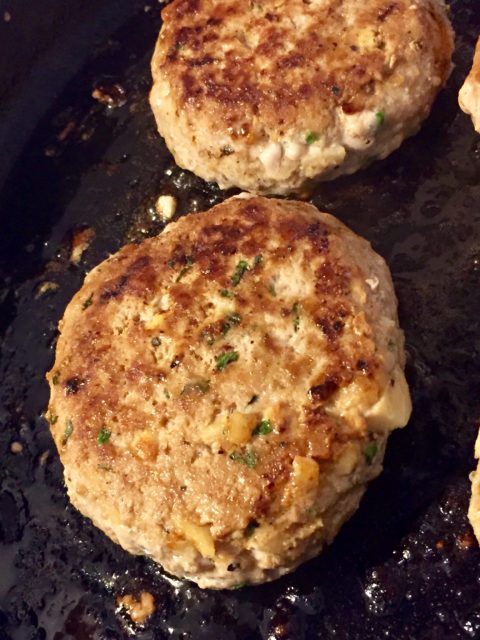 a cast iron skillet that already had a generous coating of bacon grease from the slices I fried to top the burgers. It made for a tasty caramelization on the outside of the burgers that just added another layer of flavor.
a cast iron skillet that already had a generous coating of bacon grease from the slices I fried to top the burgers. It made for a tasty caramelization on the outside of the burgers that just added another layer of flavor.
For turkey burgers, be sure to cook the burger completely to an internal temperature of at least 165 degrees. Mine took about 6 minutes per side plus the time it took to melt the cheese. Serve on a bun with your favorite BBQ sauce. To make your own BBQ sauce click here. Lettuce, onion slices, and mushrooms would be great toppers as well. I served the burgers with baked sweet potato fries.
- 1 lb ground turkey mixture
- 1 small apple (finely chopped)
- 1 T grainy mustard
- ¼ feta cheese (crumbled)
- ½ t granulated onion
- ½ t granulated garlic
- ½ t pepper
- ½ t paprika
- ¼ C fresh parsley (chopped)
- 4 slices applewood smoked bacon (cooked)
- 4 slices mild or sharp cheddar (smoked cheddar would also be tasty)
- BBQ sauce
- Fry bacon
- Mix turkey, apple, feta, parsley and seasonings
- Form four patties
- Grill or fry burgers over medium heat for about 6 minutes per side
- Melt cheese on top of the burgers
- Top with bacon slices
- Serve on bun with BBQ sauce
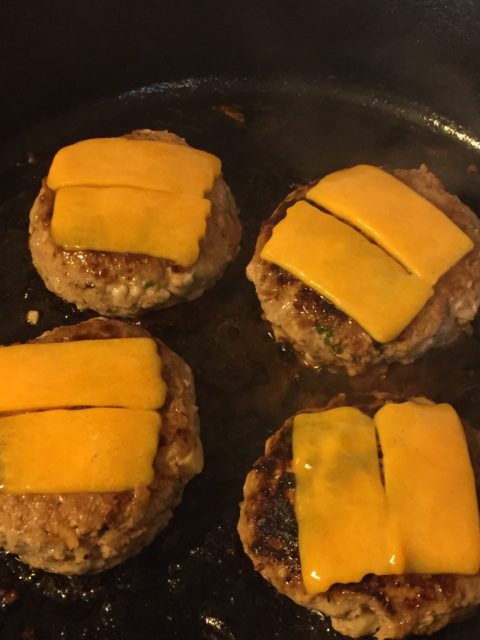
I’ve written about grilled pizza before, and for good reason: I LOVE it! For several days I have been craving this bbq chicken pizza. Typically, I would suggest preparing it with leftover bbq chicken, but I am actually grilling the chicken now, while my dough preps (I use my bread machine and it takes about an hour), so it will be ready to use on the pizzas later.
I prefer to use chicken thighs because, well, they are just a juicier, tastier piece of meat. You can substitute chicken breasts if you prefer. And, really, you could use any leftover chicken or even a pre-cooked rotisserie chicken to make the meal quicker and easier. Of course, you could use refrigerated pizza crust too, but then you are really missing out on the most fun part of homemade pizza. Kids love to do the kneading and rolling!
As I mentioned, I do sometimes use my bread machine to make my dough. You could use a packaged dough mix, but it really is simple to mix up your own dough. Most of the ingredients are typically in the fridge or pantry. I just always have to remember to pick up a few yeast packets when I’m shopping for staples because that is the ingredient I am most often missing. I do like to make the dough ahead of time so it can rise in the refrigerator. A cold rise slows the life cycle of the yeast, allowing the dough to develop more flavor. Here is my pizza dough recipe:
- ¾ C Warm Water
- 1 T Milk
- 1 T Oil
- 1 T Sugar
- ½ t Salt
- 2¼ C Flour
- 1 pkg Active Dry Yeast
- Optional: 1 t Italian Seasoning, pinch each Garlic and Onion Powder
- Place ingredients in the bread machine in the order listed (typically wet, dry, yeast) and set on dough setting.
- Once done, put on a lightly floured surface and kneed a couple of times.
- Pull apart into individual pizza size portions and roll into balls.
- Cover with plastic wrap and refrigerate until use.
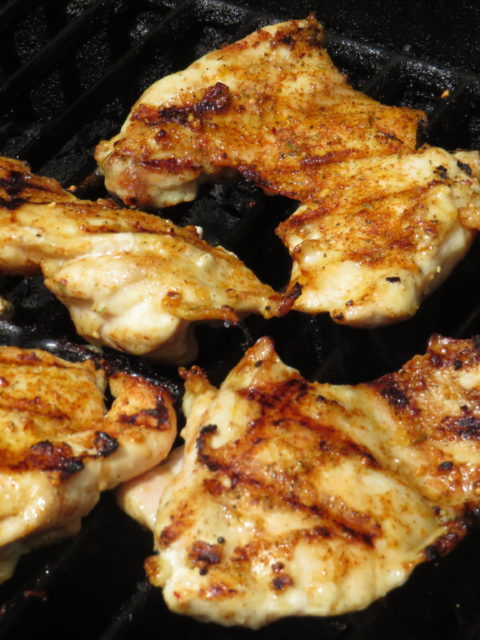 To make the chicken, I use boneless skinless chicken thighs. Other than being super tasty, they are a very inexpensive part of the chicken. Though you may be able to get them even cheaper by buying the bone-in, thighs are not the easiest to de-bone. That’s a job a leave to the meat cutter! I remove the extra fat from the pieces and then season them with my favorite bbq rub, Changing Seasonings Applewood Smoked BBQ Rub, and grill until the juices run clear.
To make the chicken, I use boneless skinless chicken thighs. Other than being super tasty, they are a very inexpensive part of the chicken. Though you may be able to get them even cheaper by buying the bone-in, thighs are not the easiest to de-bone. That’s a job a leave to the meat cutter! I remove the extra fat from the pieces and then season them with my favorite bbq rub, Changing Seasonings Applewood Smoked BBQ Rub, and grill until the juices run clear.
To top the pizzas:
BBQ Sauce (I used several: spicy, honey and a teriyaki which made a great “Hawaiian pizza”)
Chicken pieces
Green Onion
Bacon
Cheese (cheddar, colby jack, pepper jack, smoked cheddar or gouda, bleu, feta)
Other: pineapple, mushrooms, tomatoes, olives, roasted garlic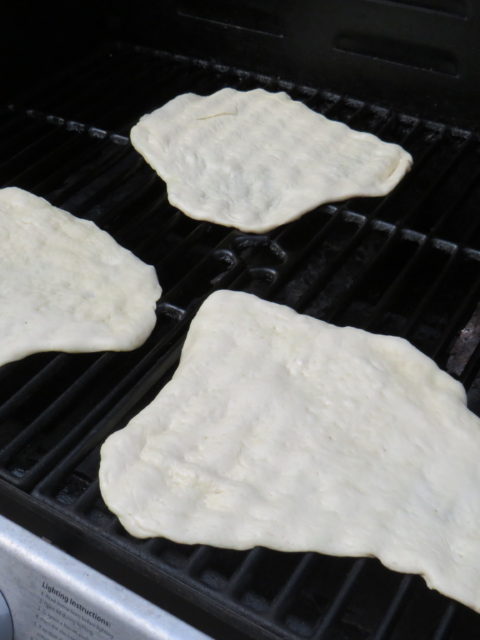
Preheat the grill and set temperature at medium-low heat. Be sure the grill rack is clean so you don’t end up with remnants of your last grilled meal in your pizza crust…yuck! Brush oil on the rack. Olive oil is definitely your friend in this process. Other than brushing it on the rack, put it on your hands and rub a little extra on each crust before cooking to keep them from sticking. Unless you are very familiar with your grill’s temperature settings and the location of any “hot spots,” start with one [test] crust…just in case! My dough took about 3-4 minutes each side.
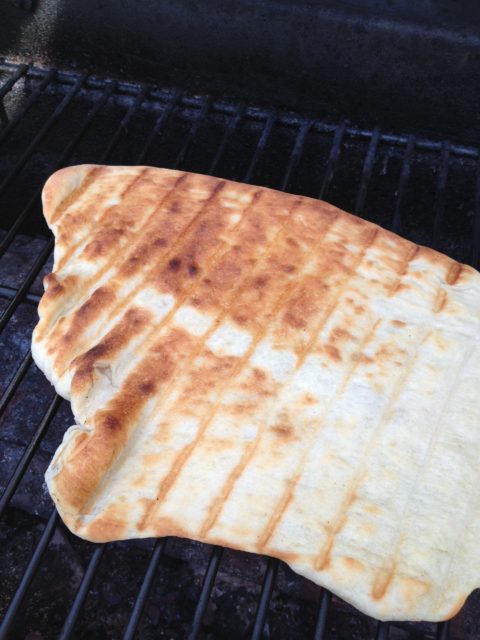 Now, comes the part where you have to act fast. Once you have flipped the crust over, quickly put on the desired toppings and get the lid closed so they can warm and the cheese can melt. If you are going to let others put their toppings on, you will need to remove the crust to the baking sheet while they top it and then put it back on the grill. Cook for the remaining 3-4 minutes until the cheese melts and the bottom is a golden brown (or darker if you prefer, I like my edges a little crisp and dark.).
Now, comes the part where you have to act fast. Once you have flipped the crust over, quickly put on the desired toppings and get the lid closed so they can warm and the cheese can melt. If you are going to let others put their toppings on, you will need to remove the crust to the baking sheet while they top it and then put it back on the grill. Cook for the remaining 3-4 minutes until the cheese melts and the bottom is a golden brown (or darker if you prefer, I like my edges a little crisp and dark.).
I had extra crust, so I made some garlic cheese bread by brushing the crust with olive oil and topping it with garlic powder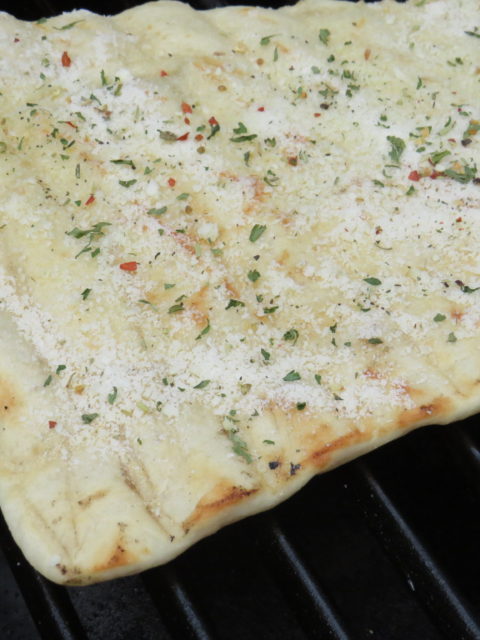 , Changing Seasonings Bread Dippin’ Blend and grated parmesan cheese.
, Changing Seasonings Bread Dippin’ Blend and grated parmesan cheese.
My favorite combination this time, teriyaki bbq sauce, chicken, bacon, green onion, pineapple, cheddar and feta chesses. I wish I would have had smoked gouda on hand. It is one of my favorite cheeses and the smokiness would have complimented the grilled chicken wonderfully.
Making individual grilled pizzas can be a lot of fun for a family or small group of people. These can be baked if say, your grill runs out of gas or the weather turns poor (both situations I can attest to from experience!).
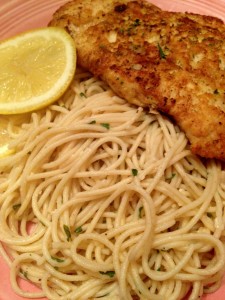
This is an easy go-to recipe that can be the center piece of many dishes. A healthier version of fried chicken. It is very economical and flexible enough to be totally casual or part of an elegant meal. Toss the cutlet on a bun for a tasty sandwich, serve with waffles and a lemon syrup, top with mozzarella and serve with spaghetti for chicken Parmesan, or serve as I did with a side of garlic and parmesan angel hair pasta and steamed asparagus.
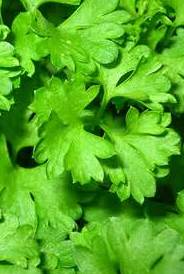 This recipe uses the herb, parsley. I have had many people comment about parsley not really having any flavor, and how it’s only supposed to be a plate garnish. So untrue! Parsley, especially fresh, is very flavorful. There are two types of parsley that you commonly see in cooking: flat leaf and curly. Flat leaf has a good flavor and is used in many traditional flavor blends. Curly parsley is often used as a garnish. Fresh parsley is typically added toward the end of cooking to maintain the flavor. You can use either dry or fresh parsley for this recipe. Just remember when using dry spices, use about 1 teaspoon of dry in place of 1 tablespoon of fresh herbs because the dry spices will have a stronger flavor. Also, when using dry spices, give them a quick grind with your hand or even a mortar and pestle to release the flavor.
This recipe uses the herb, parsley. I have had many people comment about parsley not really having any flavor, and how it’s only supposed to be a plate garnish. So untrue! Parsley, especially fresh, is very flavorful. There are two types of parsley that you commonly see in cooking: flat leaf and curly. Flat leaf has a good flavor and is used in many traditional flavor blends. Curly parsley is often used as a garnish. Fresh parsley is typically added toward the end of cooking to maintain the flavor. You can use either dry or fresh parsley for this recipe. Just remember when using dry spices, use about 1 teaspoon of dry in place of 1 tablespoon of fresh herbs because the dry spices will have a stronger flavor. Also, when using dry spices, give them a quick grind with your hand or even a mortar and pestle to release the flavor.
Okay, back to the chicken. This dish uses boneless, skinless breasts that are pounded thin, so a little goes a long way, making it an economical meal. Boneless, skinless chicken thighs could also be used.
Parmesan Lemon Chicken Cutlets
1/2 C all-purpose flour
4 chicken breasts
3 eggs
1/3 C Parmesan cheese, grated
1 T Dried Parsley, plus extra for garnish
2-3 T Olive Oil
1-2 T butter
Juice of 1 lemon, reserve lemon for garnish
Salt and Pepper to taste
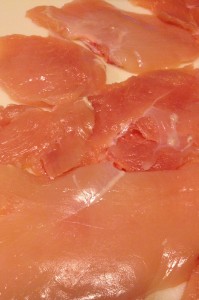
Pound the chicken breasts until they are about 1/4 inch thick. Place flour in a bowl and coat chicken pieces in flour. Shake off excess. Heat the olive oil and butter in a skillet.
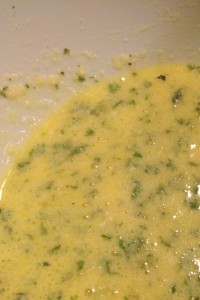
Beat the eggs, cheese, parsley, a squeeze of lemon juice, salt and pepper in a small bowl. Dip the chicken in the egg mixture. Gently shake off the excess.
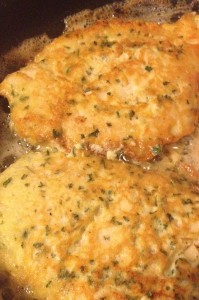
Place in the skillet. Cook until browned, about 3-4 minutes per side. Squeeze some lemon juice over the chicken while it is cooking.
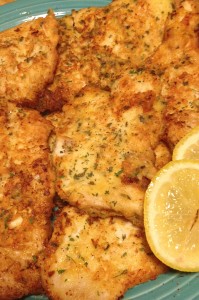
Remove from the skillet. Squeeze on more lemon juice. Garnish with a sprinkle of parsley and some lemon slices. Serve immediately.
I served these cutlets 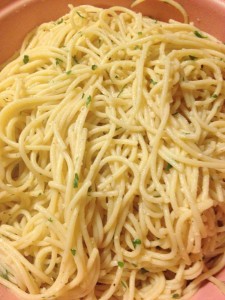 with angel hair pasta tossed with olive oil, butter, Parmesan cheese, garlic and parsley, and steamed asparagus.
with angel hair pasta tossed with olive oil, butter, Parmesan cheese, garlic and parsley, and steamed asparagus.
Once you have made these easy cutlets, you will find many dishes to use them with! Feel free to change the herb used (try cilantro or basil) and leave out the lemon, use lime or even orange instead. The combinations are endless. Enjoy!
- ½ C all-purpose flour
- 4 boneless, skinless chicken breasts
- 3 eggs (use just whites if desired)
- ⅓ C grated Parmesan cheese
- 1 T dried parsley (fresh works fine too, have a bit extra for garnish)
- ½ t kosher or sea salt
- ¼ t ground pepper
- 2 T olive oil
- 2 T butter
- Juice of 1 lemon (zest & slice the remaining lemon for additional garnish)
- Depending upon the size of the breasts, slice and pound to ¼-in thick.
- Place the flour in a shallow bowl and season with salt & pepper.
- Coat the chicken pieces with the seasoned flour.
- Beat the eggs in a small bowl, add the Parmesan, parsley and half the lemon juice.
- Heat the olive oil and butter over medium high heat in a large skillet.
- Dip the chicken pieces in the egg mixture, allowing excess to drip off.
- Place in the skillet and cooked until lightly browned, about 4-5 minutes per side.
- Squeeze additional lemon over cooking pieces.
- Remove to a warm platter and serve immediately to avoid pieces getting soggy.
- Garnish with lemon slices and additional parsley.
